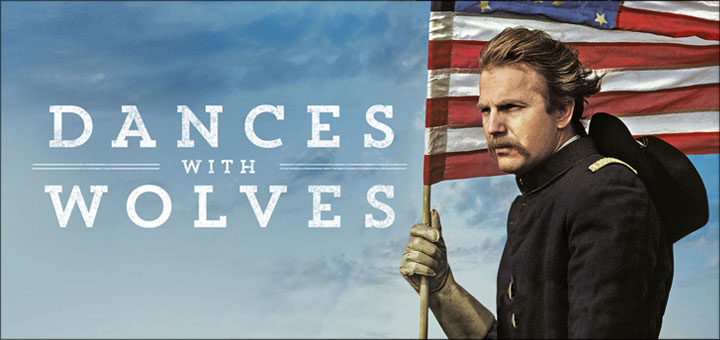Dances With Wolves (1990)

“Dances with Wolves,” released in 1990, is a monumental epic Western film that marked a significant moment in cinematic history. Directed by and starring Kevin Costner, the film not only showcases his talents as an actor but also his vision as a filmmaker. Based on the novel by Michael Blake, “Dances with Wolves” explores themes of friendship, cultural exchange, and the enduring spirit of the American West. Its rich narrative and stunning visuals have solidified its status as a classic in the genre.
Set during the American Civil War, the story follows Lieutenant John Dunbar, played by Costner, who is assigned to a remote outpost in the West. After a series of traumatic experiences on the battlefield, Dunbar seeks solace in the vast and untamed wilderness. His character embodies the themes of exploration and self-discovery, as he grapples with the duality of his identity as both a soldier and a human being seeking a connection to nature and to others.
Upon arriving at the outpost, Dunbar finds himself isolated and alone, with only the sounds of nature as his companions. This solitude serves as a catalyst for his transformation as he begins to shed the prejudices and assumptions ingrained in him by society. As he encounters a nearby Sioux tribe, led by the wise and strong-willed Chief Ten Bears, Dunbar’s understanding of the Native American culture deepens. He learns to see the Sioux people not as the enemy but as a rich culture with their own values, traditions, and way of life.
The film is notable for its authentic representation of Native American culture, which was often marginalized or misrepresented in earlier Western films. The Sioux language is prominently featured, and the film showcases their customs, beliefs, and connections to the land. This cultural portrayal fosters a sense of empathy and understanding, challenging the audience to reconsider preconceived notions about Native Americans. Dunbar’s journey reflects a broader narrative of reconciliation and respect between different cultures, emphasizing the importance of communication and shared humanity.
The relationship between Dunbar and the Sioux is a central focus of the film. Through his interactions with them, particularly with a Sioux woman named Stands With A Fist (played by Mary McDonnell), Dunbar undergoes a profound transformation. Their relationship evolves from one of curiosity to deep mutual respect and love. McDonnell’s character serves as a bridge between cultures, having been raised by the Sioux after her family was killed. This dynamic enriches the narrative, highlighting the complexities of identity and belonging.

One of the film’s most striking features is its cinematography. Shot in various locations across the American West, the film captures the breathtaking landscapes that play a crucial role in the story. The vast plains, rolling hills, and majestic mountains create a backdrop that emphasizes both the beauty and the harshness of the wilderness. The cinematographic choices enhance the themes of isolation and connection, illustrating Dunbar’s journey both physically and emotionally.
The score, composed by John Barry, further elevates the film’s emotional impact. The music underscores key moments, capturing the essence of Dunbar’s experiences—from the tranquility of nature to the intensity of conflict. Barry’s sweeping melodies evoke a sense of nostalgia and longing, complementing the film’s exploration of identity and belonging.

As the narrative progresses, Dunbar faces various challenges that test his loyalty and values. The encroachment of the U.S. Army and their relentless pursuit of the Sioux forces Dunbar to confront the harsh realities of colonialism and the destruction of indigenous cultures. These themes are not merely background elements; they are integral to understanding the historical context of the film. The tension between the Sioux and the army reflects a tragic chapter in American history, and Dunbar’s choice to stand with the Sioux against oppression symbolizes a broader fight for justice and dignity.
The film’s climax is both heartbreaking and powerful, culminating in a conflict that forces Dunbar to choose between his duty as a soldier and his loyalty to the Sioux people. This moral dilemma encapsulates the film’s central themes of honor, sacrifice, and the complexities of human relationships. The conclusion of the film leaves viewers with a sense of hope, underscoring the possibility of understanding and reconciliation, even amidst profound loss and suffering.

“Dances with Wolves” received critical acclaim and numerous awards, including seven Academy Awards, among them Best Picture and Best Director for Costner. Its impact on the Western genre is profound, paving the way for more nuanced and respectful representations of Native American cultures in cinema. The film invites audiences to engage with the narratives of those often silenced in mainstream storytelling, urging a deeper understanding of the historical and cultural complexities of the American West.
In conclusion, “Dances with Wolves” is a beautifully crafted epic that transcends the traditional boundaries of the Western genre. Through its rich storytelling, authentic representation of Native American culture, and powerful performances, the film delivers a profound message about connection, understanding, and the human experience. Kevin Costner’s vision as a director and actor brought a fresh perspective to the genre, creating a lasting legacy that continues to resonate with audiences today. It stands as a testament to the power of cinema to challenge perceptions and foster empathy, making it a timeless classic in American film history.











